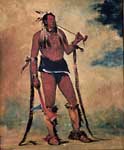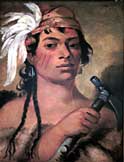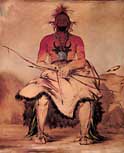
 1. |
 2. |
 3. |
||
| Native American Enemies | 1. Wah-chee-hahs-ka or Man Who Puts All Out of Doors, a Winnebago (Ho-Chunk) man. enlarge 2. Good Hunter, a Seneca (Iroquois) man. enlarge 3. La-doo-ke-a or Buffalo Bull, a Pawnee man. enlarge (watercolors by George Catlin, 1831-1835) |
|||
They wage war with 7 or 8 different nations, but do not use guns, finding them too cumbersome and slow. They carry them, nevertheless, when they march against nations who do not understand the use of them, to frighten them by the noise and put them to rout. Usually, they carry only the club, the bow, and a Quiverful of arrows, which they shoot with such skill and rapidity as scarcely to give time to those who have guns to Take Aim. (Claude Allouez, 1677)![]()
During much of the historic period, the Illinois were surrounded by tribes hostile to them. To the north were the Winnebago, whose oral traditions indicate they were among the traditional enemies of the Illinois. According to these stories the Winnebago suffered a series of disasters about 1640, including the accidental drowning of a large war party, a deadly epidemic disease, and a relentless attack by the Fox (Mesquakie) tribe. Taking pity on them, an Illinois war party of 500 men carried a large supply of food to the Winnebago village but the Winnebago responded by killing all of their Illinois guests. The Illinois retaliated several years later, killing or capturing all but a few of the Winnebago.
Among the most bitter enemies of the Illinois between 1655-1690 were the five tribes of the Iroquois Confederacy (Cayuga, Mohawk, Oneida, Onondaga, and Seneca). The Iroquois lived southeast of Lake Ontario in what is today central New York. But in the 1640s, when the supply of beavers in their own territory disappeared, the Iroquois went to war with the Huron and other Great Lakes tribes to capture their fur trade. The Iroquois routed most of the tribes they fought because their firearms, obtained from Dutch traders at present-day Albany, New York, gave them a clear military advantage. Iroquois warriors pushed the Illinois west of the Mississippi River in about 1655, and in 1680 they killed or captured more than 700 Tamaroa Illinois near the mouth of the Illinois River.
Enemies of the Illinois living west of the Mississippi River included the Missouri and Osage tribes, which lived in present-day Missouri, and the Pawnee tribe, which lived in Nebraska. Hostilities with these tribes seem to have ended in the late 1600s after the Illinois moved back to their former territory east of the Mississippi River.
New enemies emerged in the 1700s as the population and territory of the Illinois began to shrink. A loose coalition of tribes--including the Dakota (Sioux), Sauk, Fox (Mesquakie), Kickapoo, and Potawatomi--put pressure on them from the north. Meanwhile, the Chickasaw and Shawnee applied pressure from the south. By the end of the century, the Illinois were no longer able to defend themselves and they began selling their land to the United States government.![]()
|
|
Copyright © 2000 Illinois State Museum